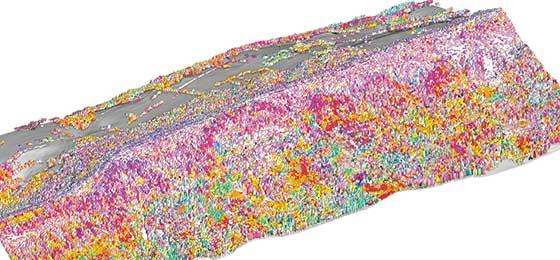Diversity - visible from afar

(From "Horizons" no. 110 September 2016)
What looks at first like an abstract
pointillist painting in fact shows
the forest in Lägern near Baden,
comprising 44,000 treetops. This
picture illustrates the relatively high
degree of diversity of biological
activity in this area in July 2015.
The rose-red dots, for example,
signify trees with a high chlorophyll
content. A team from the University
of Zurich, led by the geographer
Michael Schaepman, is using two
highly sensitive measuring devices
in an aircraft to measure the diversity
of the vegetation.
A laser scanner (lidar) scans the
surface and determines the height,
density and form of all the trees in
this area of 1.5 × 3 kilometres. An
imaging spectrometer – rather like
a camera – measures visible and
invisible colours on 500 different
channels at the same time. In this
manner, for every two-metre-long
image element, the researchers
are able to investigate the trees'
content of chlorophyll and 15 further
substances such as cellulose, water
and nitrogen.
In total, six people have been
working on this for three years,
bringing datasets together and
comparing them with information
gathered on the ground. Lägern is
one of the test areas where highly
precise methods for remote sensing
are being developed. They will then
be applied over larger areas in order
to monitor changes in biodiversity
systematically. "It means we are in
a position to measure the diversity
of biological functions to a very
precise degree", says Schaepman.
They are planning to expand their
project to cover grasslands, the
rain forests and arctic tundra. "Our
distant goal is to equip satellites
with measuring
devices".ff
Image: UZH: Fabian Schneider, Reik Leiterer,
Felix Morsdorf, Michael Schaepman